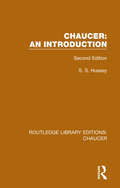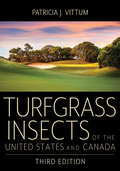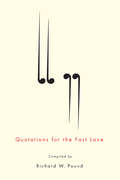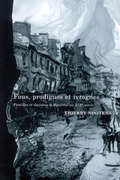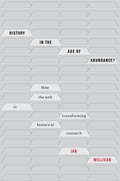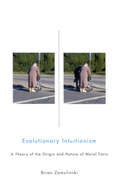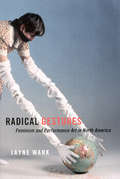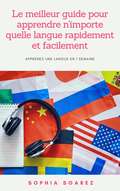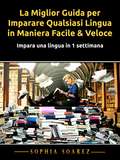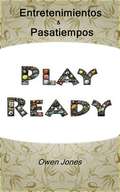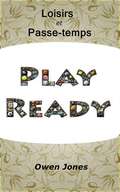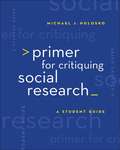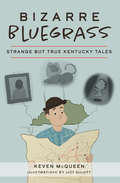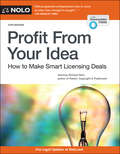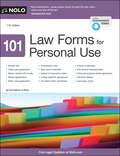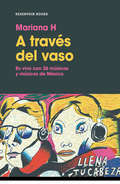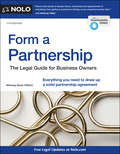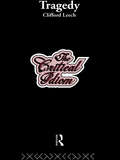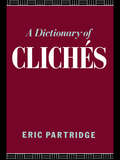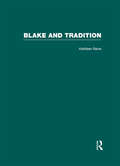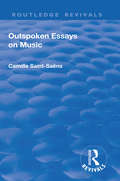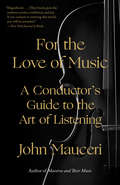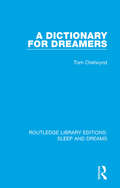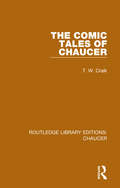- Table View
- List View
Chaucer: Second Edition (Routledge Library Editions: Chaucer)
by S.S. HusseyOriginally published in 1981, this second edition built on the success of the first which had established itself as a standard introduction to the poetry of Geoffrey Chaucer. It shows Chaucer not only in the context of his own age, but, more important, as a writer and a man who is still vivid to us so many years later. As well as examining the early poems, Troilus and Criseyde, and The Canterbury Tales the author gives a thorough account of Chaucer's background. He examines the traditions in which he wrote, his audience, and his position among his contemporaries. The second edition was updated throughout and included a number of revisions and additions, in particular on the second part of the Roman de la Rose and on The Knight's Tale.
Turfgrass Insects of the United States and Canada
by Patricia J. VittumThe first edition of this reference work became known as the bible of turfgrass entomology upon publication in 1987. It has proved invaluable to professional entomologists, commercial turf managers, and golf course superintendents and has been used widely in college extension courses. This classic of the field is now in its third edition, providing up-to-date and complete coverage of turfgrass pests in the continental United States, Hawaii, and southern Canada.This revised volume integrates all relevant research from the previous two decades. It provides expanded coverage of several pest species, including the annual bluegrass weevil, invasive crane fly species, chinch bugs, billbugs, mole crickets, and white grubs. Patricia J. Vittum also provides detailed information on the biology and ecology of all major pests and includes the most current information on conditions that favor insect development and biological control strategies pertinent to each species.This edition will include more than 100 black-and-white images, including diagrams of life cycles, sketches of morphological characteristics, and charts highlighting seasonal activity. The book also includes 72 full-color plates (more than 500 color images), showing closeup pictures of most of the key insects (adult and immature stages) and damaged turf. The reader should be able to identify most turf insects through the use of this text. It is a critical reference work that any serious turf professional should own.
Quotations for the Fast Lane
by Richard W. PoundRichard Pound has spent half a lifetime identifying, collecting, and organizing thousands of quotations. Quotations for the Fast Lane is the result of that effort, selected by someone with an impressive range of local, national, and international experience, and arranged alphabetically by theme to be easily accessible for all readers and all occasions. Words from personalities ranging from William Blake to Warren Buffett on all topics imaginable, serve to elevate and inspire. The great majority of the quotations in this book are pithy, often humorous and sardonic, but always containing an interesting perspective on life, conduct, and achievement. Quotations for the Fast Lane: "I have great faith in fools - my friends call it self-confidence." Edgar Allan Poe "It is better to be approximately right than precisely wrong." Warren Buffett "The last refuge of the insomniac is a sense of superiority to the sleeping world." Leonard Cohen
Fous, prodigues et ivrognes: Familles et déviance à Montréal au XIXe siècle (Studies on the History of Quebec/Études d'histoire du Québec #20)
by Thierry NootensÀ travers l’analyse de près de 500 procédures d’interdiction engagées entre 1820 et 1895, Fous, prodigues et ivrognes examine les interactions entre les acteurs impliqués dans la régulation de la déviance : familles, système judiciaire, institutions asilaires et médecins. Tournant le dos à l’approche institutionnelle classique, Thierry Nootens considère la famille – et non l’État, la profession médicale ou l’asile – comme le lieu principal de définition et de régulation des diverses formes de déviance.
History in the Age of Abundance?: How the Web Is Transforming Historical Research
by Ian MilliganA guide to the World Wide Web and its archives for the contemporary historian.
Evolutionary Intuitionism: A Theory of the Origin and Nature of Moral Facts
by Brian ZamulinskiEvolutionary Intuitionism presents a new evolutionary theory of human morality. Zamulinski explains the evolution of foundational attitudes, whose relationships to acts constitute moral facts. With foundational attitudes and the resulting moral facts in place, he shows how they ground a plausible normative morality, give answers to meta-ethical questions, and provide an account of moral motivation. He explains the nature of moral intuitions and, thus, of our access to the moral facts. He shows that the theory makes confirmed empirical predictions, including the observable variation in moral views. The combination of intuitionism and evolutionary ethics enables Zamulinski to overcome the standard objections to both.
Radical Gestures: Feminism and Performance Art in North America
by Jayne WarkWark brings together a wide range of artists, including Lisa Steele, Martha Rosler, Lynda Benglis, Gillian Collyer, Margaret Dragu, and Sylvie Tourangeau, and provides detailed readings and viewings of individual pieces, many of which have not been studied in detail before. She reassesses assumptions about the generational and thematic characteristics of feminist art, placing feminist performance within the wider context of minimalism, conceptualism, land art, and happenings
Le meilleur guide pour apprendre n'importe quelle langue rapidement et facilement: Apprenez une langue en 1 semaine
by Sophia SoarezUn guide détaillé pour apprendre n'importe quelle langue de manière simple et rapide Ce guide vous aidera à apprendre une nouvelle langue en 1 semaine et vous enseignera des trucs et astuces pour devenir un locuteur natif de la nouvelle langue. Basé sur des faits scientifiques, ce livre vous expliquera comment: -trouver moyen le plus simple d'apprendre une nouvelle langue -passer le temps de manière efficace -devenir locuteur natif -apprendre la prononciation correcte de la nouvelle langue -positionner la bouche pour une prononciation correcte -mémoriser des mots d'une nouvelle langue -rester motivé -améliorer l'accent Si vous voulez apprendre une nouvelle langue en une semaine et devenir un locuteur natif, alors ce livre est pour vous. -> Faites glisser vers le haut de la page et cliquez sur Ajouter dans le panier pour acheter instantanément Avis de non-responsabilité: Cet auteur et/ou le ou les titulaires des droits ne font aucune réclamation, promesse ou garantie quant à l'exactitude, l'exhaustivité ou l'adéquation du contenu de ce livre, et décline expressément toute responsabilité pour les erreurs et omissions dans le contenu. Ce produit est destiné à un usage de référence uniquement.
La Miglior Guida per Imparare Qualsiasi Lingua in Maniera Facile & Veloce: Impara una lingua in 1 settimana
by Sophia SoarezUna guida dettagliata per imparare qualsiasi lingua in modo facile e veloce Questa guida ti aiuterà ad imparare la nuova lingua in 1 settimana e ti insegnerà trucchi e suggerimenti per diventare madrelingua della nuova lingua. Sulla base di fatti scientifici, questo libro ti spiegherà: - il modo più semplice per imparare una nuova lingua - Come impiegare il tuo tempo in modo efficace - Come diventare un madrelingua - Come imparare la corretta pronuncia della nuova lingua - Come posizionare la bocca per una pronuncia corretta - Come memorizzare le parole di una nuova lingua - Come rimanere motivati - Come migliorare l'accento Se vuoi imparare una nuova lingua in una settimana e diventare un madrelingua, allora questo libro fa per te. -> Scorri fino all'inizio della pagina e fai clic su Aggiungi al carrello per acquistare immediatamente Disclaimer: Questo autore e / o il / i proprietario / i dei diritti non fanno rivendicazioni, promesse o garanzie circa l'accuratezza, la completezza o l'adeguatezza dei contenuti di questo libro e declina espressamente la responsabilità per errori e omissioni nei contenuti all'interno di esso. Questo prodotto è solo per riferimento.
Entretenimientos y Pasatiempos (Como hacer... #55)
by Owen JonesEntretenimientos y Pasatiempos Hola y gracias por comprar este libro electronico llamado, "Entretenimientos y Pasatiempos". Espero que encuentre la informacion util y rentable. La informacion de este libro electronico sobre varios aspectos de entretenimientos, pasatiempos y temas relacionados, esta organizada en 16 capitulos de aproximadamente 500-600 palabras cada uno. Espero que les interese a quienes les gusta estar haciendo algo en sus tiempos libres. Como beneficio adicional, le doy permiso para usar el contenido en su propio sitio web o en sus blogs y boletines informativos, aunque es mejor si lo reescriben con sus propias palabras primero. Tambien puede dividir el libro y revender los articulos. De hecho, el unico derecho que no tiene es revender o regalar el libro tal como se entrego. Si tiene algun comentario, dejelo en la compañia donde compro este libro. Gracias de nuevo por comprar este libro electronico. Saludos, Owen Jones
Loisirs et passe-temps (Comment faire... #55)
by Owen JonesBonjour, et merci d’avoir acheté ce livre numérique appelé “Loisirs et passe-temps” J'espère que vous trouverez ces informations instructives, utiles et intéressantes. Les informations données dans ce livre concernent divers aspects des loisirs, passe-temps et autres activités. Elles sont organisées en 16 chapitres d’environ 500-600 mots chacun. J’espère qu’elle intéresseront ceux d’entre vous qui aiment faire quelque chose de leur temps libre. Petit bonus : je vous autorise à en utiliser le contenu sur votre propre site, blog ou bulletin d’information, même s’il est préférable de le réécrire avec vos propres mots. Vous pouvez aussi diviser le livre et en revendre certains articles. De fait, le seul droit dont vous ne disposez pas est de revendre le livre tel quel. Si vous souhaitez me faire part de vos réactions, contactez le fournisseur qui vous a vendu le livre. Merci encore d’avoir acheté ce livre numérique. Cordialement Owen Jones
Primer for Critiquing Social Research: A Student Guide
by Michael J. HoloskoCritique social research with ease with Primer for Critiquing Social Research: A Student Guide! In a simple, hands-on manner, this text helps you develop the analytical tools and critical thinking skills you need to successfully critique social research. Critiquing is made easy with a book-specific website which offers frequently asked questions, an evaluation template, and other information about the text and its use.
Bizarre Bluegrass: Strange but True Kentucky Tales
by Keven McQueenFrom ghost towns to circus performers to mass hysteria, the Bluegrass State is no stranger to the strange. Read stories of famed President Abraham Lincoln you've never heard before. Find possible solutions to the mystery of Pearl Bryan's missing head and decipher the outrageous hoaxes involving an unsolvable puzzle and monkeys trained to perform farm work. Learn about the time when the author wrote to Charles Manson as a joke and Manson wrote back--four times. Join author Keven McQueen as he recounts some of the weirder vignettes from Kentucky lore.
Profit From Your Idea: How to Make Smart Licensing Deals
by Richard StimAll you need to protect and profit from your invention You’ve got a great idea and you’re ready to strike it rich. Now, you need to find a company or partner you can trust, hash out a fair licensing deal, and get your idea to the marketplace. Profit From Your Idea will help you negotiate and draft a licensing agreement that protects your interests and maximizes your chances of earning a profit. With this all-in-one guide you’ll understand how to: navigate the licensing landscape protect your intellectual property rights sort out ownership rights work with licensing agents protect confidential information find and solicit potential licensees license overseas reveal your invention safely, and negotiate and update an agreement. The 10th edition is completely updated with the latest developments in licensing law and patent filing rules, and covers industry-standard Fair, Reasonable, and Nondiscriminatory (FRAND) licensing terms. With Downloadable Forms: download forms including license agreements, assignments, joint ownership agreements, and many more (details inside).
101 Law Forms for Personal Use
by Nolo EditorsReliable legal forms for common personal and family transactions At one time or another, we all need to get an agreement in writing. But where to start? 101 Law Forms for Personal Use makes it easy to create legal agreements and organize essential information. The plain-English instructions will help you: Plan your estate: Make a simple will and use worksheets to track beneficiaries and assets. Delegate authority: Create temporary guardianship of a child, pet care agreements, limited powers of attorney, and other essential documents. Rent out a place to live: Use the rental application, move-in letter, checklist, notice of needed repairs, and other forms. Buy a house: Run the numbers with a financial statement, and then use the house comparison worksheet, moving checklist, and other forms. Borrow or lend money: Prepare a solid legal contract (promissory note). Included are five forms—one for every common borrowing/lending situation. Sell personal property: All the agreements you need to sell a motor vehicle, boat, or other valuable property. 101 Law Forms for Personal Use can also help you: settle legal disputes handle personal finances hire household help deal with spammers and telemarketers and much more With Downloadable Forms: you can download and customize all of the agreements, checklists, and other forms in this book (details inside).
Schubert's Songs: A Biographical Study
by Dietrich Fischer-DieskauIn this book Dietrich Fischer-Dieskau, one of the greatest interpreters of German Lieder, conducts a masterly study of the genesis and development of Schubert's music, revealed in terms of the composer's own life and growth to psychological maturity. Of the six hundred and eight Lieder that Schubert composed during his brief life, only a very small proportion was widely known until Dietrich Fischer-Dieskau recorded three volumes of them and began to introduce the neglected ones into his concert programs. This book sets the songs against the background of the composer's life in Vienna, revealing the relevance of his Lieder to the age he lived in. With the outstanding musicianship and complete sincerity that are the hallmarks of his art, the author discusses the brilliance and diversity of the Lieder settings, from the simple strophic to the "through composed" song and the great song cycles; and he deals in detail with the texts, which range from those by Goethe and Shakespeare to the often indifferent verses of the composer's friends. For singers and accompanists, professional and amateur musicians, record enthusiasts, and concert-goers everywhere, this is a book of inestimable value--by a great musician--about one of the greatest musicians of all time. Probably the best-known baritone in the Western world, Dietrich Fischer-Dieskau was born in Germany in 1925. Since the beginning of his career in post-World War II Germany, his influence on singers and singing has been enormous. Renowned for his performances of the songs of Schubert, Brahms, Schumann, Beethoven, Mozart, Verdi, and Wagner, he is acclaimed by musicians and critics as one of the supreme artists of our time.
A través del vaso: En vivo con 26 músicas y músicos de México
by Mariana H26 entrevistas con algunos de los protagonistas del rock y la música popular en nuestro país. Este libro contiene rock, hip hop, pop, son huasteco, metal, música experimental, un par de boleros y una polca. Contiene 26 voces en vivo de los y las protagonistas de la escena musical mexicana, de las autoras y autores de algunos de los himnos de nuestras patrias emocionales. Amandititita, Abulón, Lino Nava, Fernando Rivera Calderón, Cecilia Toussaint, Dr. Shenka, Ely Guerra, José Manuel Aguilera, Jay de la Cueva, Denise Gutiérrez, Paco Huidobro, Jaime López, Tammy Tamerlane, Tito Fuentes, Clemente Castillo, Pato Machete, Natalia Lafourcade, Joselo Rangel, Jessy Bulbo, Daniel Gutiérrez, Chema Arreola, Pepe Mogt, Silverio, Sergio Arau, Sabo Romo, Ximena Sariñana.
Form a Partnership: The Legal Guide for Business Owners
by Ralph Warner Denis CliffordThe nuts-and-bolts guide to forming a partnership A solid partnership agreement is the foundation for a lasting and successful business partnership. Don’t skip this essential step, or you might run into major problems later. Form a Partnership helps you create the agreement you need for your shared business venture. It takes you through the important issues, then helps you write your own partnership agreement tailored to your needs, clause-by-clause. The book covers: cash, property, and service contributions financial and tax liabilities how partners will make decisions allocating profits and losses admitting new partners what happens if a partner wants out buying out a partner’s interest the death of a partner and much more. The 11th edition—completely updated to reflect current law and business issues—provides the forms, worksheets, and legal information you need to create a partnership agreement. With Downloadable Forms: download and customize partnership agreements (details inside).
Tragedy (The\critical Idiom Reissued Ser. #1)
by Clifford LeechProfessor Leech considers the significance of the term ‘Tragedy’ as it has been used from classical times to the present day. He gives examples of tragic writing from a wide variety of dramatic literatures and relates theoretical writings on tragedy and the tragedies that have been contemporaneous with them. Free reference is made to critics from Aristotle to these of the present. Special stress is laid on the tragedies of the Greeks, of Renaissance writers and of our immediate contemporaries, notably Harold Pinter and Tom Stoppard. There is also discussion of tragic writing in the modern novel.
A Dictionary of Cliches
by Eric PartridgeThis work is full of things better left unsaid: hackneyed phrases, idioms battered into senselessness, infuriating Gallicisms, once-familiar quotations and tags from the ancient classics. It makes a formidable list, amplified as it is with definitions, sources, and indications of the clichés, venerability in every case.
Blake and Tradition (Routledge Library Editions Ser.)
by Kathleen RaineBlake and Tradition is an investigation of the sources of Blake's knowledge of the Neoplatonic and Hermetic tradition and allied currents of thought. The volumes contain what was then new information on Blake's vast fund of exact knowledge in these fields, and Kathleen Raine interprets his works in the light of the ideas that originally inspired and informed them.The core of this important work of scholarship formed the A. W. Mellon Lectures in the Fine Arts in 1962 at the National Gallery of Art in Washington. The expanded, two-volume work was originally published by Routledge & Kegan Paul in 1969.
Revival: Outspoken Essays on Music (Routledge Revivals)
by Camille Saint-SaensA series of essays on reactions and emotional responses to music.
For the Love of Music: A Conductor's Guide to the Art of Listening
by John MauceriWith a lifetime of experience, profound knowledge and understanding, and heartwarming appreciation, an internationally celebrated conductor and teacher answers the questions: Why should I listen to classical music? How can I get the most from the listening experience?A protégé of Leonard Bernstein--his colleague for eighteen years--and an eminent conductor who has toured and recorded all over the world, John Mauceri helps us to reap the joys and pleasures classical music has to offer. Briefly, we learn the way a musical tradition born in ancient Greece, embraced by the Roman Empire, and subsequently nurtured by influences from across the globe, gave shape to the classical music that came to be embraced by cultures from Japan to Bolivia. Then Mauceri examines the music itself, helping us understand what it is we hear when we listen to classical music: how, by a kind of sonic metaphor, it expresses the deepest recesses of human feeling and emotion; how each piece bears the traces of its history; how the concert experience--a unique one each and every time--allows us to discover music anew. Unpretentious, graceful, instructive, this is a book for the aficionado, the novice, and anyone looking to have the love of music fired within them.
A Dictionary for Dreamers (Routledge Library Editions: Sleep and Dreams #2)
by Tom ChetwyndOriginally published in Great Britain in 1972 and distilled from the collective wisdom of the great interpreters of dreams – Freud, Jung, Adler, Stekel and Gutheil, among others – this comprehensive key to the baffling language of dream symbolism is a thought-provoking and invaluable guide to the uncharted country of the mind. Tom Chetwynd has isolated for the first time the rich meanings of over 500 archetypal symbols from the indiscriminate mass of dream material, and rated the likelihoods of the various possible interpretation in each case. Here are the essential clues to understanding the ingeniously disguised, life-enriching, often urgent messages to be found in dreams.
The Comic Tales of Chaucer (Routledge Library Editions: Chaucer)
by T. W. CraikOriginally published in 1964. This book deals wholly with Chaucer’s comic tales. The individual tales are not discussed in isolation but always with reference to the others and to Chaucer’s poetry as a whole. By this comparison and analysis, this book illuminates the features of Chaucer’s many-sided art.
